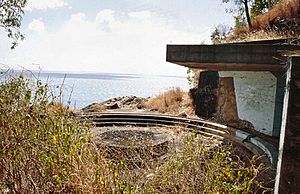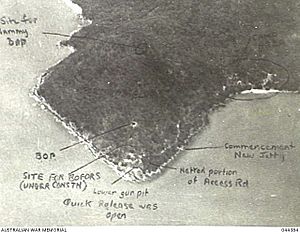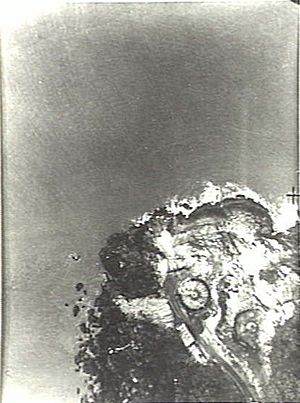False Cape Battery facts for kids
Quick facts for kids False Cape Battery |
|
|---|---|

False Cape Battery, 1996
|
|
| Location | Yarrabah Road, East Trinity, Cairns Region, Queensland, Australia |
| Design period | 1939 – 1945 (World War II) |
| Built | 1942–1943 |
| Official name: False Cape Second World War Defence Facility, Leper Bay | |
| Type | state heritage (built, archaeological) |
| Designated | 18 April 1997 |
| Reference no. | 600975 |
| Significant period | 1942–1943 (fabric) 1942–1945 (historical) 1870s–1950s (social) |
| Significant components | objects (movable) – defence, embankment – railway, gun emplacement, machine gun mounting, signal mast anchor point, magazine / explosives store, pathway/walkway, camouflage net securing points, tank – water, observation post (military), slab/s – concrete, culvert – stream |
| Lua error in Module:Location_map at line 420: attempt to index field 'wikibase' (a nil value). | |
The False Cape Battery is a special heritage site located on Yarrabah Road in East Trinity, Queensland, Australia. It's a type of old fort built between 1942 and 1943 during World War II. This important place is also known as Leper Bay. It was added to the Queensland Heritage Register on April 18, 1997, because of its historical value.
Contents
Why Was False Cape Battery Built?
The False Cape Battery was set up in late 1942 or early 1943. Its main job was to protect the port of Cairns on Trinity Inlet. Even though the battery never saw direct fighting, General Douglas MacArthur thought it was super important for defending Australia's east coast during World War II.
Early History of False Cape
False Cape was named by Captain James Cook way back in 1770. For a long time, you could only get there by boat. It became a popular spot for people to relax. In 1884, about 100 acres of land from False Cape to Sunny Bay was made a special area for a Pilot Station. This area grew to 250 acres by 1910.
Later, in 1889, the bay on the southwest side of the Cape became a temporary place to isolate sick people. This is why it was called Leper Bay for a while. However, this practice stopped in the 20th century, and the beach was renamed Sunny Bay.
Australia's War Preparations
When World War II started in September 1939, Australian military experts looked for places to build coastal defenses near Cairns. They considered the Esplanade in Cairns or the area from Lyons Point to False Cape. By April 1940, they decided not to build defenses for Cairns.
Even though Japan was becoming more aggressive in the Pacific Ocean, and the Premier of Queensland, William Forgan Smith, kept asking for forts along the coast, the Australian Government didn't do much. They thought they couldn't defend the whole country. So, they focused on protecting the industrial areas in southeast Australia. In March 1942, they even declared the area north of Mackay, Queensland a war zone and encouraged people to leave North Queensland.
Cairns Becomes a Key Base
Things changed when General Douglas MacArthur became the Supreme Commander of Allied Forces in the South West Pacific. US military forces, who had been defeated in the Philippines, moved to north Queensland. Townsville became a main base, but both the Royal Australian Navy and the United States Navy used Cairns more because its port was less busy.
Cairns also became an important air base for the Royal Australian Air Force's Catalina planes. After the Battle of the Coral Sea and Battle of Midway in mid-1942, the war moved north to New Guinea. Cairns then became a crucial supply base for the New Guinea offensive. The Australian Army also set up big training and hospital camps nearby on the Atherton Tableland.
Building the False Cape Battery
Even with all this military activity, Cairns harbour wasn't protected until General MacArthur ordered coastal defenses for important ports. Between 1942 and 1943, nineteen two-gun batteries, called 'Letter Batteries', were built across Australia and New Guinea. MacArthur asked for powerful 155mm guns and searchlights from Washington to equip these batteries.
In 1942-1943, Cairns was the closest major Australian port to the war in the South Pacific. It was vital to protect ships moving through Grafton Passage from enemy attacks or mines. On December 25, 1942, 127 men from H Australian Heavy Battery arrived in Cairns to build and operate the False Cape Battery. The chosen spot was perfect for guarding the path from Cairns Harbour to the open sea.
Setting Up the Camp
At first, H Battery soldiers lived in tents near a small stream at Sunny Bay. Later, local workers built camp buildings using timber from a sawmill. These buildings included barracks, officers' quarters, kitchens, a canteen, and a small room for electricity. There was also a workshop and a hospital.
There was no road from Cairns to the camp, so supplies came by boat. A timber jetty was built at Sunny Bay, and a stone and concrete ramp was made closer to the Cape for landing barges. Since the stream at Sunny Bay only flowed in the wet season, water was pumped from another creek further south. A rough road was cut from Sunny Bay to False Cape, and a truck carried supplies. A small rail line was also built to winch heavy equipment up the hill to the Battery Observation Post.
The Defence Structures
The main defence structures at False Cape were made of concrete. They included:
- Two gun emplacements (places where the big guns were set up).
- A battery observation post (BOP) to spot targets.
- A main magazine to store 400 rounds of 155mm ammunition.
- Smaller magazines for ammunition right next to each gun.
An anti-aircraft gun was placed above the main magazine. All these structures were hidden with camouflage netting.
The Battery Observation Post was where soldiers measured how far away targets were and their direction. This information was used to aim the guns correctly. The higher the observation post, the better the rangefinder worked. False Cape's high ridge was perfect for this.
Searchlights and Signals
The 105 Coastal Artillery Searchlight Section, with about 13 engineers, helped H Battery. They operated two large 150cm searchlights to spot enemy ships at night. One might have been near the jetty at Sunny Bay, and the other on the eastern side of the Cape.
In December 1943, the Royal Australian Navy set up a Port War Signal Station at False Cape. This station communicated with ships. They might have shared the observation post with the army or had their own building. The signal station closed in June 1945.
The Battery After the War
H Australian Heavy Battery stayed at False Cape until early 1944, when they moved to Townsville. S Battery replaced them and stayed until the war ended in August 1945. The guns and searchlights were removed at this time.
After the war, the timber camp buildings and water pipes were sold to the nearby Yarrabah Mission. Only the concrete slabs where the buildings stood remained. Fishermen later built small huts on some of these slabs.
In 1946, the Australian Government officially took over 298 acres at False Cape, thinking they might keep a defence facility there. However, in 1947, the land was declared not needed by the army. It was then leased to private businesses, including a tourist operator in the 1950s. False Cape and Sunny Bay became popular recreation spots again, with small weekend shacks built there. The land was sold to private owners in 1969.
What Can You See at False Cape Battery Today?
False Cape is about 9.5 km northeast of Cairns by air, but about 40 km by road. Many parts of the old coastal artillery battery and its support base are still there.
Gun Emplacements
There are two gun emplacements, one higher up and one lower down. They are made of strong concrete. They have circular pits where the guns would recoil (move back) when fired. You can still see points where camouflage nets were attached. The lower emplacement still has its magazine doors. These concrete structures are very strong and different from other batteries built at the time.
Battery Observation Post (BOP)
This two-level concrete building is on the high ridge above the guns. It was used to house the rangefinder and the command post. You can still see the outdoor timber stairs and fittings on the roof that held the camouflage netting. The top level has original timber window frames for observation and concrete blocks where the rangefinder was mounted. The lower level is a large room. Both levels show signs of being used as living spaces later on.
Main Magazine
The main magazine is also made of concrete. It has a corridor around three sides of two rooms, built into the side of the hill. You can still see marks from the racks where ammunition was stored.
Machine Gun Position
Above the main magazine, there's a mount for an anti-aircraft gun. It's a steel pipe with flat ends. This is believed to be the only anti-aircraft gun mount left from a World War II coastal battery in Queensland.
Signal Station Anchor
A steel ring set in a concrete slab might have been where the signal mast for the Port War Signal Station was anchored.
Winch Area and Cutting
On the western side of the Cape, below the BOP, there's a concrete and rock path leading to the water. Old photos show a rock jetty here. A rusty gearbox nearby might be from the winch. Above the road, there's an overgrown cutting where a rail line was used to winch equipment from the road and beach up to the BOP. A concrete slab at the top of the cutting might have been part of this winch area.
On the eastern side of False Cape, only a concrete platform on a stone foundation remains of the base end station.
Rock with Platform at Sunny Bay
At the north end of Sunny Bay beach, there's a large granite rock with a concrete platform on it. This platform once supported walls.
Road and Camp Site
About 500 yards south of the defence structures, you can still find evidence of the old camp site at Sunny Bay. This is where the soldiers lived. The road from the camp to the defence area is still usable. There's a concrete culvert where it crosses a stream. A concrete rainwater tank is on the ridge between the camp and the Cape. The camp area is now overgrown, but you can see several concrete slabs that were once foundations for buildings. Three timber stumps in the foreshore at Sunny Bay are what's left of the old timber jetty.
Why is False Cape Battery Important?
False Cape Battery was added to the Queensland Heritage Register in 1997 for several reasons:
- It shows Queensland's history: The battery was the main coastal defence for Cairns, which was a very important port during World War II for moving supplies and troops.
- It's unique: It's thought to be the last surviving World War II complex in the Cairns area. It helps us understand Australia's role in building coastal defenses during the war.
- It can teach us more: The site can still provide more information about how all the parts of this battery worked together. This includes the gun emplacements, observation post, magazine, the camp at Sunny Bay, and the roads and jetties.
- It shows how these places were built: The battery shows the main features of a World War II coastal battery in Queensland. Its unique design and location help us understand how it was meant to operate.
- It's beautiful: The whole area is beautiful, and the defence structures themselves stand out as important landmarks.
- It's important to the community: The place has been a popular spot for recreation for over 120 years. It also has a special connection to World War II, which greatly impacted Cairns and the surrounding area.



